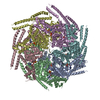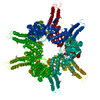[English] 日本語
 Yorodumi
Yorodumi- PDB-6j0f: Cryo-EM Structure of an Extracellular Contractile Injection Syste... -
+ Open data
Open data
- Basic information
Basic information
| Entry | Database: PDB / ID: 6j0f | ||||||
|---|---|---|---|---|---|---|---|
| Title | Cryo-EM Structure of an Extracellular Contractile Injection System, PVC sheath/tube terminator in extended state | ||||||
 Components Components |
| ||||||
 Keywords Keywords | PROTEIN TRANSPORT / assembly / Photorhabdus asymbiotica / PVC / contractile injection system / bacteriophage-like | ||||||
| Function / homology | Pvc16, N-terminal / Pvc16 N-terminal domain / Conserved hypothetical protein CHP02241 / Bacteriophage T4, Gp19, tail tube / T4-like virus tail tube protein gp19 / structural molecule activity / Pvc16 N-terminal domain-containing protein / Conserved hypothetical phage tail region protein Function and homology information Function and homology information | ||||||
| Biological species |  Photorhabdus asymbiotica subsp. asymbiotica (bacteria) Photorhabdus asymbiotica subsp. asymbiotica (bacteria) | ||||||
| Method | ELECTRON MICROSCOPY / single particle reconstruction / cryo EM / Resolution: 3.8 Å | ||||||
 Authors Authors | Jiang, F. / Li, N. / Wang, X. / Cheng, J. / Huang, Y. / Yang, Y. / Yang, J. / Cai, B. / Wang, Y. / Jin, Q. / Gao, N. | ||||||
 Citation Citation |  Journal: Cell / Year: 2019 Journal: Cell / Year: 2019Title: Cryo-EM Structure and Assembly of an Extracellular Contractile Injection System. Authors: Feng Jiang / Ningning Li / Xia Wang / Jiaxuan Cheng / Yaoguang Huang / Yun Yang / Jianguo Yang / Bin Cai / Yi-Ping Wang / Qi Jin / Ning Gao /  Abstract: Contractile injection systems (CISs) are cell-puncturing nanodevices that share ancestry with contractile tail bacteriophages. Photorhabdus virulence cassette (PVC) represents one group of ...Contractile injection systems (CISs) are cell-puncturing nanodevices that share ancestry with contractile tail bacteriophages. Photorhabdus virulence cassette (PVC) represents one group of extracellular CISs that are present in both bacteria and archaea. Here, we report the cryo-EM structure of an intact PVC from P. asymbiotica. This over 10-MDa device resembles a simplified T4 phage tail, containing a hexagonal baseplate complex with six fibers and a capped 117-nanometer sheath-tube trunk. One distinct feature of the PVC is the presence of three variants for both tube and sheath proteins, indicating a functional specialization of them during evolution. The terminal hexameric cap docks onto the topmost layer of the inner tube and locks the outer sheath in pre-contraction state with six stretching arms. Our results on the PVC provide a framework for understanding the general mechanism of widespread CISs and pave the way for using them as delivery tools in biological or therapeutic applications. | ||||||
| History |
|
- Structure visualization
Structure visualization
| Movie |
 Movie viewer Movie viewer |
|---|---|
| Structure viewer | Molecule:  Molmil Molmil Jmol/JSmol Jmol/JSmol |
- Downloads & links
Downloads & links
- Download
Download
| PDBx/mmCIF format |  6j0f.cif.gz 6j0f.cif.gz | 414 KB | Display |  PDBx/mmCIF format PDBx/mmCIF format |
|---|---|---|---|---|
| PDB format |  pdb6j0f.ent.gz pdb6j0f.ent.gz | 346.5 KB | Display |  PDB format PDB format |
| PDBx/mmJSON format |  6j0f.json.gz 6j0f.json.gz | Tree view |  PDBx/mmJSON format PDBx/mmJSON format | |
| Others |  Other downloads Other downloads |
-Validation report
| Summary document |  6j0f_validation.pdf.gz 6j0f_validation.pdf.gz | 799.1 KB | Display |  wwPDB validaton report wwPDB validaton report |
|---|---|---|---|---|
| Full document |  6j0f_full_validation.pdf.gz 6j0f_full_validation.pdf.gz | 803.2 KB | Display | |
| Data in XML |  6j0f_validation.xml.gz 6j0f_validation.xml.gz | 56.5 KB | Display | |
| Data in CIF |  6j0f_validation.cif.gz 6j0f_validation.cif.gz | 81.7 KB | Display | |
| Arichive directory |  https://data.pdbj.org/pub/pdb/validation_reports/j0/6j0f https://data.pdbj.org/pub/pdb/validation_reports/j0/6j0f ftp://data.pdbj.org/pub/pdb/validation_reports/j0/6j0f ftp://data.pdbj.org/pub/pdb/validation_reports/j0/6j0f | HTTPS FTP |
-Related structure data
| Related structure data |  9763MC  9760C  9761C  9762C  9764C  9765C  6j0bC  6j0cC  6j0mC  6j0nC M: map data used to model this data C: citing same article ( |
|---|---|
| Similar structure data |
- Links
Links
- Assembly
Assembly
| Deposited unit | 
|
|---|---|
| 1 |
|
- Components
Components
| #1: Protein | Mass: 32373.434 Da / Num. of mol.: 6 Source method: isolated from a genetically manipulated source Source: (gene. exp.)  Photorhabdus asymbiotica subsp. asymbiotica (strain ATCC 43949 / 3105-77) (bacteria) Photorhabdus asymbiotica subsp. asymbiotica (strain ATCC 43949 / 3105-77) (bacteria)Strain: ATCC 43949 / 3105-77 / Gene: PAU_03338, PA-RVA20-21-0156 / Production host:  #2: Protein | Mass: 16532.557 Da / Num. of mol.: 6 Source method: isolated from a genetically manipulated source Source: (gene. exp.)  Photorhabdus asymbiotica subsp. asymbiotica (strain ATCC 43949 / 3105-77) (bacteria) Photorhabdus asymbiotica subsp. asymbiotica (strain ATCC 43949 / 3105-77) (bacteria)Strain: ATCC 43949 / 3105-77 / Gene: PAU_03353, PA-RVA20-21-0171 / Production host:  |
|---|
-Experimental details
-Experiment
| Experiment | Method: ELECTRON MICROSCOPY |
|---|---|
| EM experiment | Aggregation state: HELICAL ARRAY / 3D reconstruction method: single particle reconstruction |
- Sample preparation
Sample preparation
| Component | Name: sheath/tube terminator and the last layer of tube in contracted state Type: COMPLEX / Entity ID: all / Source: RECOMBINANT |
|---|---|
| Source (natural) | Organism:  Photorhabdus asymbiotica (bacteria) Photorhabdus asymbiotica (bacteria) |
| Source (recombinant) | Organism:  |
| Buffer solution | pH: 7.4 |
| Specimen | Embedding applied: NO / Shadowing applied: NO / Staining applied: NO / Vitrification applied: YES |
| Vitrification | Instrument: FEI VITROBOT MARK IV / Cryogen name: ETHANE / Humidity: 100 % |
- Electron microscopy imaging
Electron microscopy imaging
| Experimental equipment |  Model: Titan Krios / Image courtesy: FEI Company |
|---|---|
| Microscopy | Model: FEI TITAN KRIOS |
| Electron gun | Electron source:  FIELD EMISSION GUN / Accelerating voltage: 300 kV / Illumination mode: FLOOD BEAM FIELD EMISSION GUN / Accelerating voltage: 300 kV / Illumination mode: FLOOD BEAM |
| Electron lens | Mode: BRIGHT FIELD / Alignment procedure: COMA FREE |
| Specimen holder | Cryogen: NITROGEN / Specimen holder model: FEI TITAN KRIOS AUTOGRID HOLDER |
| Image recording | Electron dose: 46.4 e/Å2 / Detector mode: INTEGRATING / Film or detector model: FEI FALCON II (4k x 4k) |
- Processing
Processing
| CTF correction | Type: PHASE FLIPPING AND AMPLITUDE CORRECTION |
|---|---|
| Symmetry | Point symmetry: C6 (6 fold cyclic) |
| 3D reconstruction | Resolution: 3.8 Å / Resolution method: FSC 0.143 CUT-OFF / Num. of particles: 45000 / Symmetry type: POINT |
 Movie
Movie Controller
Controller








 PDBj
PDBj